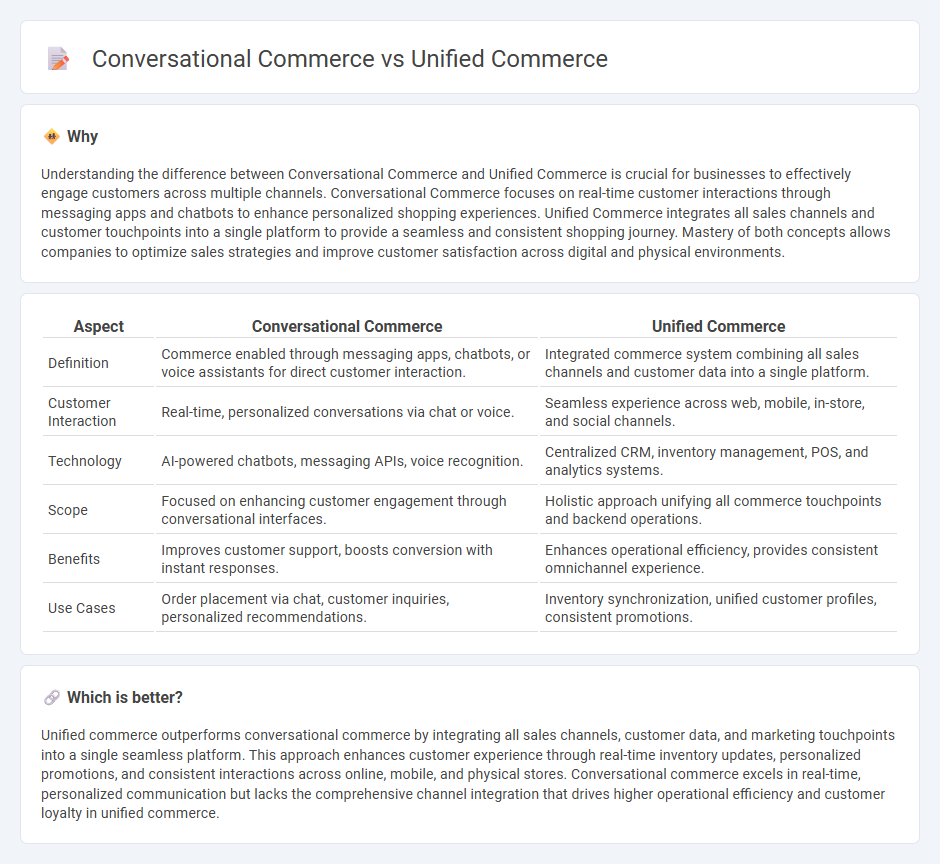
Conversational commerce leverages chatbots and messaging apps to facilitate real-time, personalized customer interactions, enhancing user experience through natural language processing and instant support. Unified commerce integrates all sales channels, including online, in-store, and mobile platforms, into a seamless system that provides consistent inventory, pricing, and customer data management. Explore the evolving landscape of commerce to understand how these approaches revolutionize customer engagement and operational efficiency.
Why it is important
Understanding the difference between Conversational Commerce and Unified Commerce is crucial for businesses to effectively engage customers across multiple channels. Conversational Commerce focuses on real-time customer interactions through messaging apps and chatbots to enhance personalized shopping experiences. Unified Commerce integrates all sales channels and customer touchpoints into a single platform to provide a seamless and consistent shopping journey. Mastery of both concepts allows companies to optimize sales strategies and improve customer satisfaction across digital and physical environments.
Comparison Table
| Aspect | Conversational Commerce | Unified Commerce |
|---|---|---|
| Definition | Commerce enabled through messaging apps, chatbots, or voice assistants for direct customer interaction. | Integrated commerce system combining all sales channels and customer data into a single platform. |
| Customer Interaction | Real-time, personalized conversations via chat or voice. | Seamless experience across web, mobile, in-store, and social channels. |
| Technology | AI-powered chatbots, messaging APIs, voice recognition. | Centralized CRM, inventory management, POS, and analytics systems. |
| Scope | Focused on enhancing customer engagement through conversational interfaces. | Holistic approach unifying all commerce touchpoints and backend operations. |
| Benefits | Improves customer support, boosts conversion with instant responses. | Enhances operational efficiency, provides consistent omnichannel experience. |
| Use Cases | Order placement via chat, customer inquiries, personalized recommendations. | Inventory synchronization, unified customer profiles, consistent promotions. |
Which is better?
Unified commerce outperforms conversational commerce by integrating all sales channels, customer data, and marketing touchpoints into a single seamless platform. This approach enhances customer experience through real-time inventory updates, personalized promotions, and consistent interactions across online, mobile, and physical stores. Conversational commerce excels in real-time, personalized communication but lacks the comprehensive channel integration that drives higher operational efficiency and customer loyalty in unified commerce.
Connection
Conversational commerce leverages real-time messaging platforms to facilitate direct customer interactions and transactions, seamlessly integrating with unified commerce systems that consolidate sales channels, inventory, and customer data into a single platform. This integration allows businesses to provide consistent, personalized shopping experiences across multiple touchpoints, enhancing customer engagement and operational efficiency. Unified commerce supports conversational commerce by enabling synchronized data flow, ensuring accurate product availability and order tracking during conversations.
Key Terms
Omnichannel Integration
Unified commerce integrates all retail channels and customer touchpoints into a single, seamless system, enhancing inventory visibility, customer data consistency, and streamlined purchasing experiences. Conversational commerce leverages AI-driven chatbots and messaging apps to facilitate personalized interactions and real-time customer engagement across various platforms. Explore how these strategies drive seamless omnichannel integration and transform customer experiences.
Real-time Communication
Unified commerce integrates multiple sales channels into a single platform, ensuring consistent customer experiences and centralized data management in real-time. Conversational commerce leverages AI-powered chatbots and messaging apps to facilitate instant, personalized communication and transactions directly with customers. Explore how real-time communication transforms customer engagement and boosts sales efficiency.
Customer Journey
Unified commerce integrates all sales channels and customer touchpoints into a single platform, ensuring seamless interactions throughout the customer journey. Conversational commerce leverages chatbots, messaging apps, and voice assistants to facilitate real-time, personalized customer engagement and support. Explore how these strategies transform customer experiences and drive business growth by learning more about their impact.
Source and External Links
Unified Commerce: The Future of Seamless Shopping (2024) - Shopify - Unified commerce is a fully integrated retail system that lets merchants manage all sales channels, inventory, order fulfillment, and marketing from a single platform to provide seamless, personalized shopping experiences across online, in-store, and other channels.
Unified commerce 101: A guide - Stripe - Unified commerce is a business strategy integrating all sales channels, data, and backend systems such as inventory and CRM into one seamless platform to offer a fully integrated and personalized customer experience and optimize retail operations.
What Is Unified Commerce--And Why Is It Essential in 2025 and Beyond - Kibo Commerce - Unified commerce platforms unify backend retail solutions to create a single source of truth for customer data, orders, and sales channels, enabling real-time insights and a consistent customer experience across all touchpoints.
 dowidth.com
dowidth.com